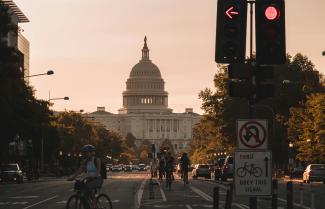
The 2024 Presidential Election and the Stock Market
The 2024 election campaigns of president Joe Biden and former president Donald Trump are well underway. Voters continue to mull over their options. Investors may think that having a Democrat or Republican sitting in the Oval Office plays better in the stock market. US history suggests otherwise. The party of the winner doesn’t matter to the market for many reasons.
Markets have typically thrived under both parties
Neither party can claim superior economic or market performance. The stock market posted positive returns across most administrations, with the rare exceptions of presidencies that ended in deep recessions. The S&P® 500 Index has delivered an average annual return of approximately 10% since it started in 1957 through both Democratic and Republican administrations.1 The US economy also expanded around 3% during that period.2
The stock market’s return was negative for a presidential administration only when the country was in a financial crisis (2008) or experiencing a stagflationary spiral (1973).3
Investing and politics don’t mix
Hypothetically, the best-performing portfolio from 1900 to 2023 was the “bipartisan” one that stayed fully invested during both Democratic and Republican administrations. Starting with $10,000, this portfolio grew to almost $9.9 million.
A “partisan” portfolio, only invested during administrations of one party or the other in that 123-year span, underperformed by millions of dollars. The same $10,000 only invested during Democratic administrations grew to approximately $528,000. Invested only during Republican administrations, the initial $10,000 rose to just shy of $181,000.4
The different results are, in part, because of the US stock market’s consistent rise even during two world wars and major financial crises (the Great Depression and the 2008-2009 Global Financial Crisis). The more time investors spent participating in markets, the better their investments did.
Staying fully invested vs. choosing political sides
Growth of $10,000 in the Dow Jones Industrial Average since 1896
Sources: Haver, Invesco, 12/31/23. The Dow Jones Industrial Average is a price-weighted index of the 30 largest, most widely held stocks traded on the New York Stock Exchange. An investment cannot be made in an index. Past performance does not guarantee future results.
US economy isn’t radically re-engineered
Investors are often concerned that elected officials will radically re-engineer the economy. In fact, the composition of the US economy has been consistent for decades. Even single-party rule periods didn’t result in significant change. The percentage of “substantive” bills by Congressional term hasn’t increased when one party controlled the executive and legislative branches.5
Neither party is fiscally responsible
Federal spending has outpaced taxes and other sources of government revenue in most years and across most administrations.6 No party can claim fiscal responsibility. It hasn’t been a significant issue for a variety of reasons, including the US having the world’s largest reserve currency and nominal economic growth outpacing the interest expense as a percent of gross domestic product (GDP).
Monetary policy matters more
For all the focus on the executive branch, I’d argue that it’s monetary policy that matters more. The old adage holds true: Don’t fight the Fed. Historically, presidents have been hurt or helped by monetary policy conditions. For instance, both Presidents Reagan and Clinton benefited from consistently falling interest rates. Both Presidents George H.W. Bush and George W. Bush were hurt by Fed tightening, an inverted yield curve, and a recession. President Obama benefitted from a benign rate environment (minus a brief moment in 2015-2016) during his term, and President Trump was the unfortunate recipient of tighter policy during his first two years.7
President’s popularity doesn’t matter
Investors don’t have to love what is going on in Washington, DC, to prosper in the markets. In fact, the S&P 500 historically performed the best when the president’s approval rating was in the low range — between 35 and 50.8 That means the market had delivered some of its best returns during periods when half or more of the country didn’t approve of the job the current administration was doing! Still, it’s hard to discern any direct relationship between a president’s popularity, the health of the US economy, and the performance of financial markets.
Markets performed best when presidents weren’t so popular
S&P 500 Index return by presidential approval rating (1961 – Jan. 2024)
Sources: Bloomberg, L.P. and Gallup, 1/31/24. The presidential approval ratings were introduced to gauge public support for the president of the United States during the term. For illustrative purposes only and not intended as investment advice. An investment cannot be made in an index. Past performance does not guarantee future results.
Investment opportunities continue despite who’s president
Investors should be less interested in politics and more interested in private-sector business leaders who are going to harness artificial intelligence and robotics. They may be able to help cure debilitating diseases, evolve the nation’s energy sources, and develop new technologies and industries that aren’t even on the radar.
History suggests that innovations — and investment opportunities — will continue irrespective of who wins a presidential election. The period since 2008, for instance, has included Democratic and Republican presidents. Many innovations were introduced during this time including 3D printing, cloud computing, gene editing, and virtual meeting software.
Original Article: Brian Levitt, Invesco. "The 2024 presidential election and the stock market".

